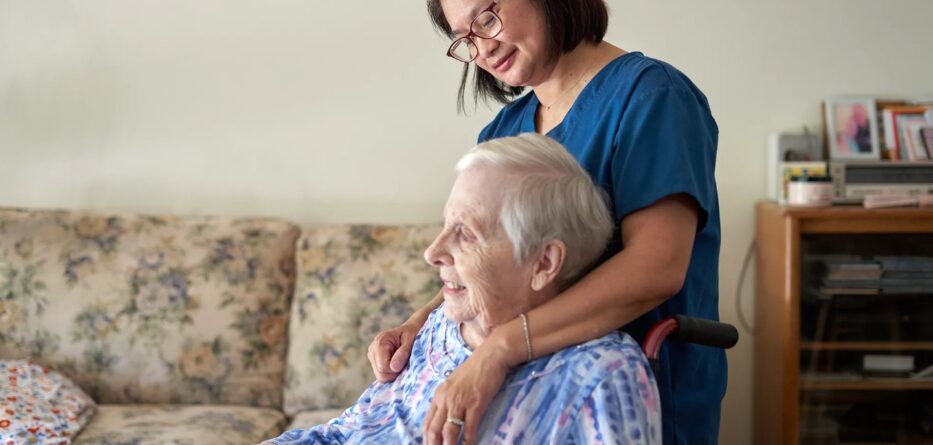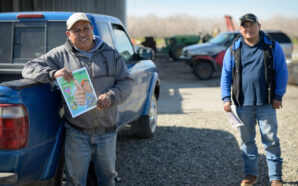The hardest parts of Grace Diaz’s caregiving job are the sleepless nights and aches and pains. And the time away from her family.
Even when Diaz’s client, an elderly Alzheimer’s patient, gets a good night’s sleep, Diaz wakes up at her slightest rustle or groan. Diaz’s shoulder bothers her because she often lifts her client from bed to wheelchair.
She lives with her client in Westminster, a city in Orange County, seven days a week, making $15.50-an-hour and sending some to her children back home in the Philippines, from which she emigrated 20 years ago.
Diaz, who is 56, worries that when she needs care, she won’t be able to afford it.
“We take care of the elderly, but I’m not even sure that, if I stay here, I’m going to have the same care that I’m giving right now — if I’ll be able to afford it,” said Diaz.
Like many of California’s caregivers, Diaz says she needs a living wage, safer working conditions and benefits.
That’s important not just for in-home workers, advocates say, but for California’s Baby Boomers, who will need to hire them.
California’s caregiver workforce is already too small, experts say, and many are aging immigrants like Diaz, earning near-minimum wages. A few state lawmakers have introduced bills to protect workers and encourage growth in the workforce.
“The need for care is going to more than double in the next 12 years here in California, and it’s happening across the country,” said Arnulfo De La Cruz, president of the Service Employees International Union (SEIU) Local 2015, which represents long-term care workers throughout California. “We’re a country that’s aging, and how do we want to care for people when they age?”
California caregivers undervalued, underpaid
By 2030, nearly 1 in 5 Californians will be age 65 or older, according to the nonprofit Public Policy Institute of California. The state will be facing a shortage of as many as 3.2 million care workers by then, said Susan DeMarois, director of the California Department of Aging.
Caregiving has been an undervalued field, largely because its workers are predominantly immigrant women, said Fernando Torres-Gil, director of the UCLA Center for Policy Research on Aging.
“We don’t, as a society, value or honor persons that do caregiving,” Torres-Gil said.
In California 80% of care workers are women, 74% are people of color and 47% are immigrants, according to PHI, a New York-based research and elder policy nonprofit.
Caregivers who work in homes or nursing centers often earn minimum, or close to minimum, wages, Torres-Gil said, and they lack benefits and safety protections typical of 9-to-5 jobs.
That makes careers in long-term care a hard sell for young people, he said.
The solution is two-pronged, said Aquilina Soriano Versoza, executive director of the Pilipino Workers Center of Southern California. Long-term care workers should receive living wages and benefits good enough to attract and retain them, she said, and government systems should help Californians pay for the care they’ll need as they age.
“It’s a shortage of good jobs,” she said of caregiving. “People are not going into care work, even though it’s one of the fastest growing jobs, because of the conditions and what it’s paid.”
Bottom of Form
Caregivers’ pay
The state and counties help set that pay. The state’s In-Home Supportive Services Program serves 700,000 Californians, paying for in-home care for low-income residents age 65 and older and others who are disabled.
It’s funded with a mix of government money. A state audit in 2020 showed California contributing $4.5 billion, counties $1.6 billion and the federal government $7.2 billion.
The in-home program pays caregivers, who help people stay in their homes. Caregivers’ pay rates are negotiated by the counties where they work and the unions that represent them.
Workers often complain about slow negotiations stymied by regional politics.
In Kern County, for instance, six years of bargaining for a new contract yielded a recent county offer of 50 cents an hour more on the $15.50 base pay. Sandy Moreno, who left a career in labor to care for her grandmother, said showing up at county supervisors meetings didn’t change things.
“It just feels like they don’t really care about IHSS providers,” she said. “No matter how many times we go to their sessions to talk about our work, to let them know we need to invest in this program, it just feels like we’re at the end of their list.”
The Fresno County Public Authority and SEIU Local 2015 are also in active negotiations for caregiver contracts. Sal Quintero, the only Latino Fresno County supervisor, said he supports organized labor and caregivers — his brother was a caregiver — but “we have to be careful with our county budget and see what’s affordable for us as well.”
Statewide bargaining?
A few state lawmakers introduced bills designed to improve pay and working conditions for caregivers.
Assemblymember Matt Haney, a Democrat from San Francisco, authored a bill earlier this year to shift collective bargaining for publicly funded caregiver contracts from counties to the state. Labor supporters said that would make contracts more fair across the state and allow care workers to move across county lines.
“Who would you want caring for someone you love,” asked De La Cruz, “someone who’s making poverty wages, no retirement and little benefits? Or someone who has a living wage and is able to have benefits to care for their own families?”
The bill passed the Assembly, but Haney said he pulled it before a Senate vote after agreeing, in discussions with Gov. Gavin Newsom’s administration, that the state needs time to flesh out logistics and finances for statewide bargaining for caregivers.
Newsom’s budget includes $1.5 million for a working group on the issue. Haney said he expects its findings in 2025. Newsom also agreed to increasing state fines for counties that fail to promptly reach contract agreements with caregivers.
The United Domestic Workers said in a statement, “This is a vital first step towards bringing equity and a true living wage” to in-home caregivers.
Opponents of Haney’s proposal said counties have varying needs and costs of living that statewide rates likely won’t address. Assemblymember Bill Essayli, a Riverside Republican, said in a statement he voted against the bill because it would impose a one-size-fits-all approach.
“The way we can actually support these workers is by focusing on policies in Sacramento that address our affordability crisis,” he said. “For example, stopping the upcoming gas tax increase July 1 would greatly benefit IHSS workers, who drive more than other workers.”
In-home worker safety
Senator María Elena Durazo, a Democrat from Los Angeles, introduced a proposal this year to include home caregivers in the state’s oversight of workplace safety. Her bill, which targets a variety of domestic workers, passed the Senate and is in the Assembly Appropriations Committee.
Currently, California’s safety work rules don’t apply to domestic workers, including caregivers in private homes. If approved, Durazo’s bill would change that. It’s her third bill to improve domestic worker safety.
In 2020 she proposed extending the Division of Occupational Safety and Health (Cal/OSHA) protections to domestic workers, but Newsom vetoed it.
In 2021, taking feedback from Newsom, she proposed creating an advisory committee on domestic workers for Cal/OSHA. That led to California’s first voluntary occupational health and safety guidelines for domestic workers.
If Durazo’s latest bill becomes law, Cal/OSHA would have the authority to develop and enforce its health and safety guidance for employers, making in-home work safer and more desirable, she said.
“It’s a very isolating job, to be one caregiver in a person’s home,” Durazo said. “They’re vulnerable to exploitation. So we want to make sure … they would have the same rights as other workers.”
That sounds like a good idea to Diaz, who said it would help caregivers in difficult employment situations. Caregiving is not for the faint of heart, she said. It requires physical and emotional strength.
Sometimes her client yells at her out of the blue, she said. On better days, they do arm exercises in the garden or listen to soothing music in the living room.
Diaz likes her work. With her own family thousands of miles away, Diaz said her client has become like family.
“She’s like a mother to me,” Diaz said.






